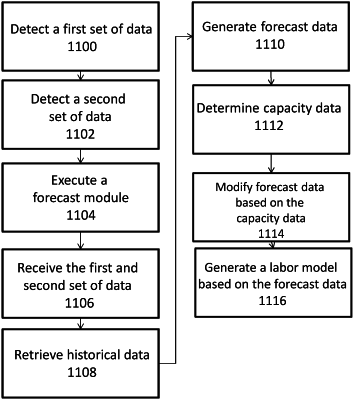| CPC G06Q 10/063118 (2013.01) [G06Q 10/04 (2013.01); G06Q 10/0633 (2013.01); G06Q 10/06375 (2013.01)] | 20 Claims |

|
1. A forecasting system using machine learning to reiteratively adjust forecast data, the forecasting system comprising:
a storage device storing a database including information associated with a plurality of facilities, the information including for each facility historical data and labor models indicating an amount of labor employed at the facility at a plurality of time periods; and
a computer system having a plurality of processors and memories in communication with the database storing a forecasting module comprising a machine learning algorithm that reiteratively adjust the forecast data, the computer system configured to:
receive a request to generate the forecast data indicative of an amount of workers needing to be scheduled in one of the plurality of facilities for a specified amount of time;
determine a current time in relation to the specified amount of time associated with the forecast data;
generate temporary data tables in the database holding data associated with delivery or retrieval of a plurality of physical objects disposed in the plurality of facilities;
execute the machine learning algorithm to generate slope data representing a calculated change in orders or items week over week for each facility of the plurality of facilities using inputs including historical and labor model data retrieved from the database and data associated with the delivery or retrieval of physical objects disposed in the facility retrieved from the temporary data tables;
execute the machine learning algorithm to generate the forecast data for the specified amount of time including physical object predictive data associated with a quantity of physical objects to be disposed in each facility of the plurality of facilities and a quantity of physical objects to be retrieved from or delivered from each facility of the plurality of facilities, using the generated slope data,
wherein the physical object predictive data is iteratively updated based on updates to the slope data;
transmit the forecast data to render on a display of a user device the forecast data indicating an amount of workers needed in the facility for the specified amount of time to disposed in and to retrieved from the facility the plurality of physical objects;
execute the machine learning algorithm to generate a correction factor for comparison with previous correction factors associated with the facility to evaluate accuracy of prior forecast data for the facility for a given period;
execute the machine learning algorithm to apply the generated correction factor to the slope data to generate an updated forecast data based on a comparison of the generated correction factor with a previously generated correction factor applied to the facility;
transmit and cause the updated forecast data to be rendered on the display of the user device; and
dynamically adjust, responsive to the forecasting module, schedule of workers scheduled working at the facility based on the updated forecast data.
|